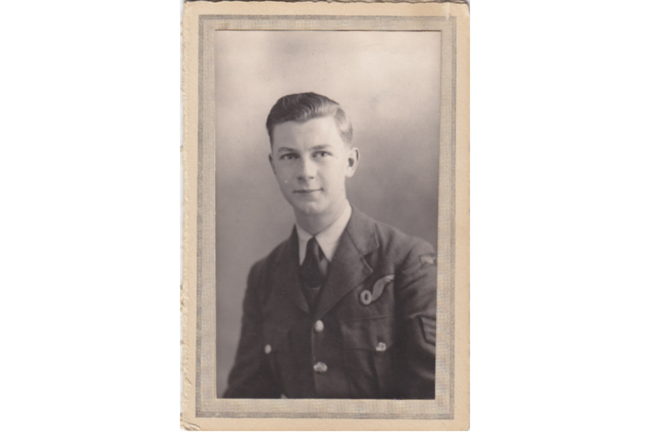
"My father’s role supporting the D-Day landings"
Published:
Categories:
Fund supporter Ann Blowers’ father, John Jenkins, was a Flight Sergeant during the Second World War – serving as a Bomb Aimer in Bomber Command. To mark the 81st anniversary of D-Day, Ann talks us through the operations her father was part of between 5-14 June 1944.
John joined the RAF in 1942 aged 18. After a year of training, John formed a crew in November 1943, with his first operation taking place on 5 June 1944, supporting the D-Day landings with 550 Squadron.
5 June 1944
On 5 June, John and his crew were briefed to attack a coastal battery commanding a strategic position on the Cherbourg peninsula. The Crisbecq battery was a Second World War artillery battery near the French village of Saint-Marcouf and formed a part of Germany’s Atlantic Wall coastal fortifications. 550 Squadron’s Operations Record Book stated:
All aircraft took off promptly and without incident. Although some cloud was encountered across England on the outward journey enough was seen to realise that the whole of southern England was on the move. Whilst flying across the Channel a vast armada of ships was seen making their way towards France. At the target 10/10th cloud was encountered but the glow from the markers was seen quite distinctly beneath. All crews agreed that the bomb flashes, as far as could be judged, were well centred around the marker. The Flak around the target was negligible and very few incidents were reported by our crews who all returned safely after participating in the opening phase of the invasion of Europe.
6 June 1944
John and his crew were briefed to attack the rail junction at Achères near Paris. 550 Squadron’s Operations Record Book stated:
Nineteen aircraft and crews were offered for operations and briefed to attack the rail junction at Achères. The weather was cloudy and quite a few of the aircraft brought their bombs back on orders from the Master Bomber. The evidence of those who saw and bombed the markers together with the tale told by their photographs, gave every indication that this particular junction no longer exists.
9 June 1944
The crew were briefed once more, this time to target enemy airfield Flers – one of the targets of strategic bombing of Normandy. It aimed to reduce the advance of German reinforcements being brought in by air because the railways were blocked. Eighty per cent of the town was destroyed. As stated in the Squadron’s record book:
The weather difficulties were less than expected and all crew claim a successful attack. Owing to low cloud over the target, bombing took place from various heights and several reports of visual identification indicate that the airfield, believed to be used by day fighters, was both accurately marked and bombed; several explosions were seen. The whole force on this target returned without loss.
14 June 1944
Sixteen aircraft were briefed to attack the dock area of the French port of Le Havre, with the aim to hit fast German motor-torpedo boats and other light naval forces which were threatening Allied shipping off the Normandy beaches only 30 miles away from the port. The logbook said:
Sixteen aircraft were called for to attack the dock area of the French port of Le Havre one hour after sunset, which necessitated a daylight take-off, much to the delight of all the crews. Weather conditions at the target were ideal for the operation. All the aircraft and crews returned safely and are looking forward eagerly to some more daylight raids - referred to as the bomb aimers’ paradise.
Two days later, John’s plane was shot down over Holland, and after several weeks’ evasion, John became a Prisoner of War in July 1944. He was finally demobbed in March 1946.
Ann didn’t know much about her father’s time in the RAF until after his death in 2003. She said: "Like a lot of returning servicemen, he didn’t speak much about his time in the Second World War. We found his letters when he passed away, which led us to do more research and learn about the operations he was a part of. It was very emotional."
She added: "Since the unveiling of the Bomber Command Memorial, I have become a big supporter of the Fund – they do so much to help veterans and serving personnel. It’s important for me to continue to support the Fund in my father’s memory."